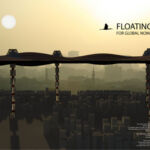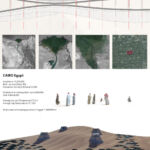Innovative Floating Desert: A Nomad City for Cairo
Project's Summary
Cairo, the largest city in Africa and the 16th most populous metropolitan area in the world, is known for its dense population. In addition to its permanent residents, Cairo is also home to a nomadic population, which makes up around 1% of the country's total population, ranging between 500,000 and 1 million individuals. However, over the years, these nomadic communities have faced challenges including neglect and persecution from the government. This has led to a decline in their numbers, as many have chosen to settle in urban areas and assimilate into Egypt's dominant culture.
Recognizing the need to provide a space for the nomadic population, the concept of Floating Desert was born. This innovative project aims to create a city that caters to the unique needs and lifestyle of global nomad dwellers. Located in a generic district of Cairo, Floating Desert offers an integration of different ways to experience the city, combining both permanent and nomadic living.
The city is designed with the co-existence of columns and a desert suspended platform. The columns serve as the permanent residential areas, incorporating mixed-use spaces such as housing, social areas, cooling systems, and vertical transportation. To combat the extreme heat, the façade system consists of a wall with insulation boards that help regulate temperature.
On the other hand, the desert suspended platform provides a flexible environment for nomadic living. It is designed to simulate a desert environment and is equipped with solar panels and a water system fed by the columns' cores. The platform is intentionally left incomplete and open, reflecting the nomadic nature of its inhabitants. It aims to create a space that celebrates the originality and essential nature of raw materials.
The Floating Desert project is structured in three levels. The first level houses the "permanent" city, integrating existing buildings with the columns' gates. This level also features green areas and open spaces that invite both nomads and permanent residents to enjoy a new living experience. Vertical elements connect the permanent and nomad cities, allowing for seamless movement between the two.
At the second level, the floating suspended platform takes center stage. This flexible environment provides oasis areas for shade and connects the desert with the lower permanent city through vertical lifts. The entire building system prioritizes energy efficiency, with solar panels located between the sand to harness the power of the sun.
In conclusion, the Floating Desert project, created by the Zoo Office architectural studio, aims to address the unique needs of the nomadic population in Cairo. By providing a space that combines permanent and nomadic living, this innovative concept city offers a new way for global nomads to experience urban life. With its integrated design and focus on sustainability, Floating Desert presents an exciting opportunity for the future of urban planning and architecture.
Read also about the Revolutionizing Urban Living: Marion Green Courtyard Townhomes project


